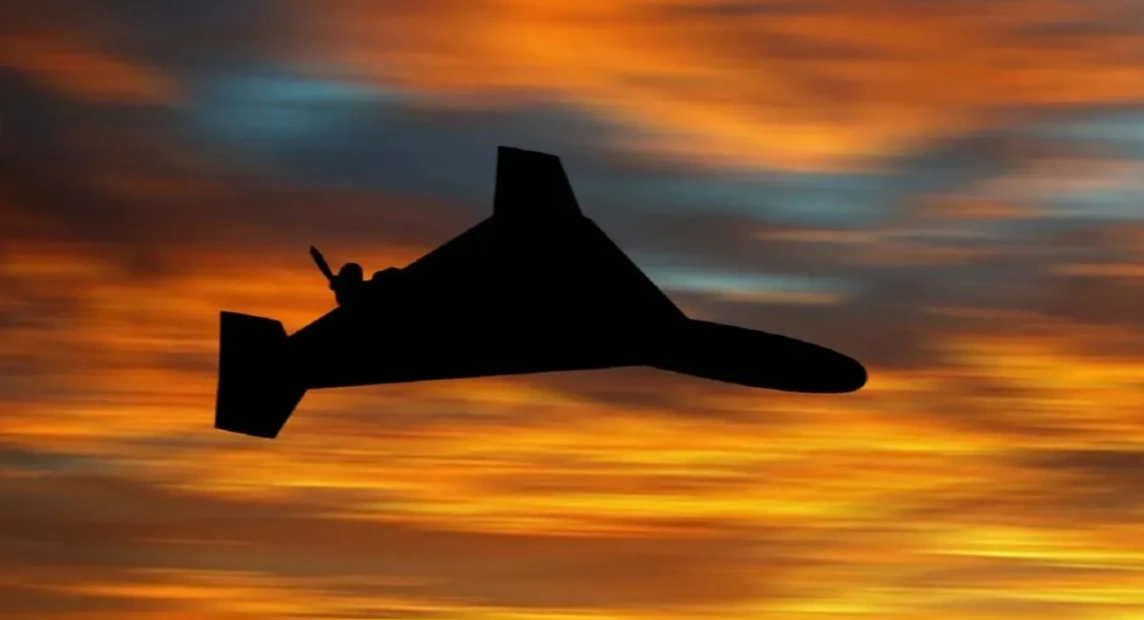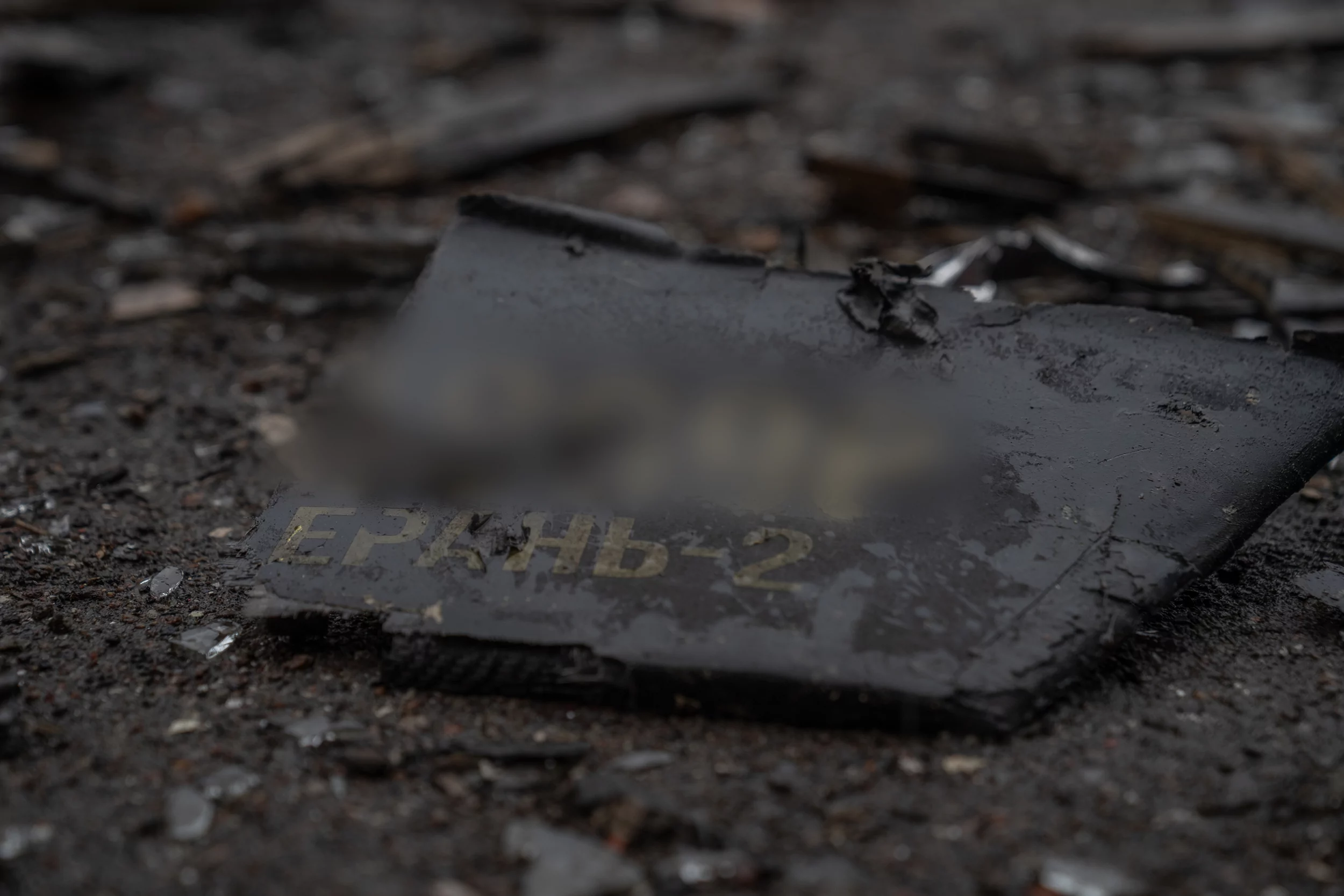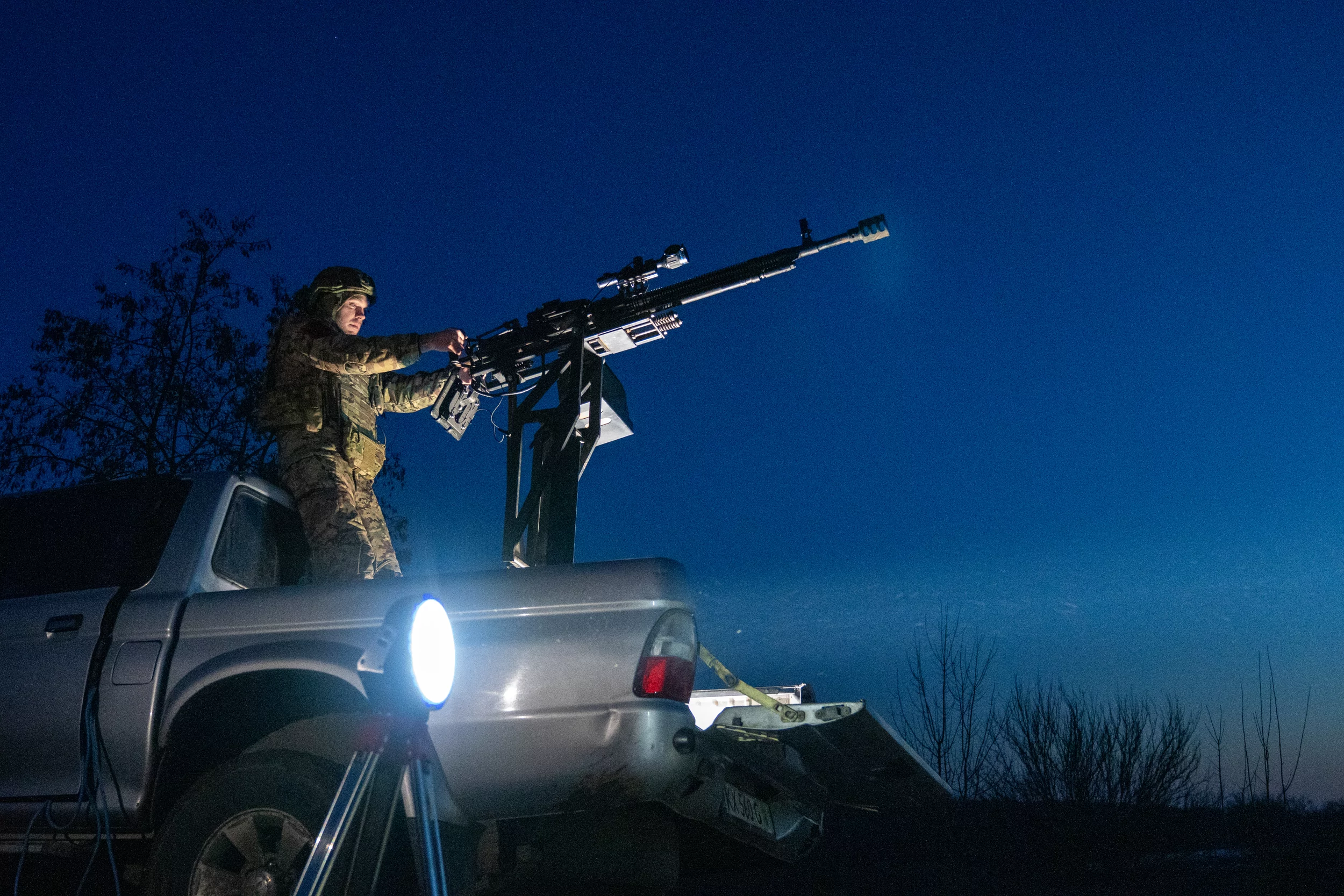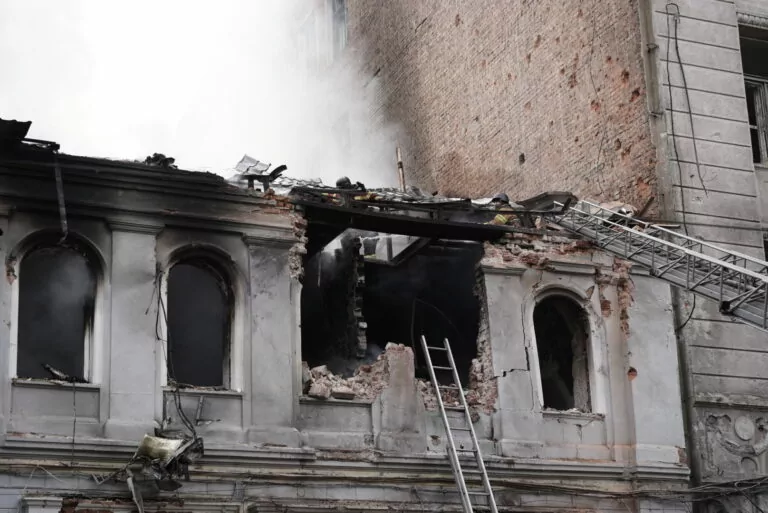UKRAINE, KHARKIV OBLAST — In the first year of the full-scale invasion, Russia has started using cheap, Iranian-made Shahed drones instead of expensive missiles to attack Ukrainian cities. These drones were cost-effective and flexible, capable of changing altitude and trajectory mid-flight.
Using expensive interceptor missiles to target cheap kamikaze drones couldn’t be justified, so Ukraine abandoned traditional air defence tactics and created mobile air defense units — also called mobile firing groups — soldiers on pickup trucks with mounted machine guns.
In 2025, Russia started launching concentrated wave-like attacks across the country, with swarms of kamikaze drones hitting one or two targets in its cities and villages, creating another immense challenge for Ukraine’s air defence.
Back in April, Gwara spoke to Kharkiv authorities and air defence soldiers about changes in Russian drone tactics and technology. With Moscow’s drone strikes becoming even more massive and deadly this summer — now, Russian troops can strike Ukraine with up to 800 strike drones per day — we’re releasing this article in English, updated to include new developments.
Change of tactics
According to the Shahed Tracker project, this June, Moscow used 5,438 Shahed drones to strike the territory of Ukraine with 104 drones per day on average. Kharkiv, Ukraine’s second-largest city in the northeast, was hit with at least 116 Shahed-like drones throughout the last month.
At least half of those drones are targeting civilian infrastructure in the industrial zone, Dmytro Chubenko, a spokesperson for the Kharkiv Regional Prosecutor’s Office, told Gwara Media.
“They choose a specific business or a certain area and subject it to massive shelling,” Chubenko said.
On July 16, during one of such attacks, Russia launched 16 kamikaze drones at a single enterprise in the Kyivskyi district of the city — the explosions, without a pause, lasted for up to 20 minutes.
Countering such attacks in Kharkiv is tough. The distance from the border with Russia to Kharkiv is 20–30 kilometers (12-19 miles), depending on the point in the city that the Russian attack drones are trying to reach. Ukrainian air defense has to monitor this huge area and be able to use anti-drone measures within it, tracking and downing Shaheds that travel at a speed of about 200 kilometers (124 miles) per hour, Chubenko said.
Additionally, the Russian army frequently switches the launch sites and sends drones to fly low, lifting them properly only near Kharkiv, which complicates the work of those who track them even more.

“Currently, Russians concentrate their flights at very low altitudes, up to 200 meters, which are difficult to detect by radar due to blind spots — or, on the contrary, launch drones to fly very high, 1,000–4,000 above, out of reach of of mobile air defence’s machine guns,” a commander of an air defence unit said to Gwara.
He, like another soldier we spoke to in April, wished to stay anonymous due to the tacit ban on talking to the press about air defence that came from Ukraine’s high military command.
“From a certain sector, groups of Shaheds consisting of 5–10 drones fly in at different altitudes. There are only two goals: overload the Ukrainian air defense system and identify positions (of Ukraine’s air defense) to later attack them so that they can launch what they need along the same route.”
Russian domestic upgrades to Shaheds
Nowadays, Russians attack with Geran-2 drones, Chubenko says, which are 90-95% identical to the Iranian design of Shaheds, but with some adaptations. Moscow’s production changed chips, wires, cameras, and GSM systems.
The drone’s warhead in the nose compartment can contain various types of munitions — cluster, thermobaric, or high-explosive.
“Theoretically, even a nuclear warhead can be installed there. Its size is 30×40 centimeters — you can put any explosive there, or nothing at all,” said Chubenko.
After the detonation, it is challenging to establish what kind of explosives were used because almost nothing remains of the Shahed or Geran-2. Only drones with cluster munitions can be identified because when such a drone explodes, small elements fly around and damage the facades of buildings.
Russians may have made their Geran-2 faster by improving the motor. There is information about the installation of additional jet engines that accelerate unmanned aerial vehicles (UAVs) either before impact or in certain areas of the territory to quickly bypass air defense systems, Chubenko said.
According to him, cases like these have been recorded in Ukraine and possibly in Kharkiv, but there is a lack of details because almost nothing is left of the drone after the explosion.
Russians established their manufacturing for Geran-2 in Elabuga, Tatarstan. On June 15, drones struck Elabuga, located approximately 1,000 kilometers from Ukraine. While Ukrainian forces have previously targeted this facility, Kyiv refrained from commenting on these strikes.
Import substitution also allowed Russia to modernize the Shaheds and make them more resistant to electronic warfare (EW) technology, said Yurii Fedorenko, commander of the “Achilles” regiment in the Public Interest Journalism Lab’s podcast.
Although one of the Geran-2 production facilities was damaged, Russians can, according to Fedorenko, manufacture 300 Shahed-like units per day.
Decoy drones
“Dummies have been used for a long time — dummies of airplanes at airfields, artillery, air defense systems, radars, etc. This is one of the traditional tactics of warfare. It is not something extremely new or unique, but the Russians have adapted it to the reality of drone strikes,” Chubenko says.
The Prosecutor’s Office explains that decoys can fly into a city, circle, and then return to Russian territory or continue flying. They have no warhead and are made of foam or wood, so they don’t cause serious damage when shot down or crashed.
They do, however, impact Ukraine’s capacity to defend the sky. According to the commander of the air defense unit, drone swarms with decoys are overloading Ukraine’s air defense system, both radar surveillance and mobile firing groups. Radars cannot clearly distinguish between 3-4 simultaneous targets, showing them as one.
Russians also use decoy drones to locate Ukrainian air defense systems and study radar coverage at different altitudes — to model future flight paths.
There are two main types of decoy drones, “Gerbera” and “Parodya,” Chubenko said. ‘Parodya’ is an airplane-type drone. It looks like a Shahed on the radar, is similar in speed, and is perceived by military air defense as a real air target. The Gerbera is bigger — its shape is very similar to the Geran-2.
Luneburg lenses, installed inside both, serve as radar reflectors, making both types of decoys appear larger on radars, like real kamikaze drones.
What’s next
The solution for countering swarms of Russian drones is a multi-layered and dense air defense system, said another anonymous military source to Gwara.
In response to the high number of modernized Geran-2 and the onslaught of EW-resistant fiber-optic drones, Ukrainian volunteers and military personnel began advocating for the increased deployment of interceptor drones.
“Russia is going to devastate our entire country with Shaheds. If we don’t act now, our infrastructure, production, and defense facilities will be destroyed,” warns Serhii Beskrestnovy, a military expert in communications and electronic warfare. “The main focus should be on mass-producing interceptor drones and training military personnel nationwide in their use. We are out of time.”
In July, President of Ukraine Volodymyr Zelenskyy said that, to defend the sky, the air defence launched interceptor drones that downed “dozens” of targets. Back then, Russia hit Ukraine with over 500 drones of various types. At the Ukraine Recovery Conference in Rome, Zelenskyy called for Ukraine’s allies and partners to “boost investments” in interceptor drones.
There’s also a critical lack of personnel in the Ukrainian army. Since Russia intensified its offensive in the Donetsk region in the summer of 2024, Ukraine has faced a shortage of infantry at the front and began transferring aviation and air defence specialists to infantry units.
“This will continue as long as we are led by people who blindly follow orders and are unable to stand their ground, that’s the first thing,” said our source in the air defence back in April. “Secondly, according to the leadership, sometimes the collapse of the front is much more strategically scary than a limited air defense.”
The issue of personnel transfer remained unnoticed until a video surfaced on January 14, 2025, in which Air Force personnel reported orders to transfer them to infantry, provoking a reaction from the top leadership. President Volodymyr Zelenskyy assured that critical Air Force specialists would not be transferred, and the General Staff of the Armed Forces denied plans for a large-scale transfer of aviation specialists to rifle regiments. Military experts have criticized this approach as “wasteful,” as specialists who have spent years developing their professional skills often die or get injured in infantry positions.
“We can all criticize (these decisions), but we only see one part of the picture. We do not have enough weapons and ammunition to hit all the targets. All of this is extremely expensive, and it takes time to expand the (air defense) system, — and during that time, people continue to die. We also face the slowness of Western decision-making and Trump’s impulsiveness and dependence in making such decisions,” summarized Gwara’s source in the military.
This article was written and translated by Polina Kulish, Gwara’s reporter and video department editor — thank you for reading it and following what’s happening in Ukraine. Please, consider also supporting our Kharkiv-based newsroom by buying us a coffee or subscribing to our Patreon to back our reporting long-term.
Read more
- Ukraine launches platform for testing foreign defense technologies “on real battlefield”
- Russian troops attempt to build pontoon bridges across the Oskil River to launch an assault on Kupiansk





